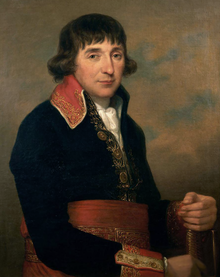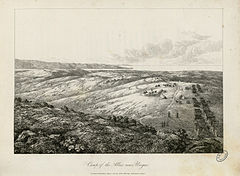| Augustin de Lespinasse | |
|---|---|
 Portrait by Angelica Kauffmann, 1798 Portrait by Angelica Kauffmann, 1798 | |
| Born | 8 October 1737 (1737-10-08) Pouilly-sur-Loire, France |
| Died | 23 November 1816 (1816-11-24) (aged 79) Paris, France |
| Allegiance | |
| Service | Artillery |
| Years of service | |
| Rank | General of Division |
| Battles / wars | |
| Awards | Légion d'Honneur, GO 1804 Order of the Iron Crown, 1807 Order of Saint-Louis, 1814 |
| Other work | Sénat conservateur, 1804 Count of the Empire, 1808 Chamber of Peers, 1814 |
Augustin de Lespinasse (8 October 1737 – 23 November 1816) commanded French artillery during the French Revolutionary Wars. After fighting in the Seven Years' War he switched to the artillery branch. He advanced in rank to major by 1788 and was attached to the Army of the Rhine in 1791. After transferring to the Army of the Western Pyrenees as chief of artillery, he coolly directed the successful defence of the Sans Culottes Camp in February 1794. He was soon promoted to general of division but the Minister of War blocked his continued employment.
Lespinasse transferred to the Army of Italy under Napoleon Bonaparte in 1796. He fought with distinction at Castiglione, Rovereto, Arcole and Mantua. Thereafter he published a treatise on the organization of artillery. After becoming emperor Napoleon appointed Lespinasse to the Senate and gave him other honors. LESPINASSE is one of the names inscribed under the Arc de Triomphe, on Column 35.
Early career
Lespinasse was born in Pouilly-sur-Loire on 8 October 1737. He joined the Black Musketeers of the Maison du Roi and later in 1759 he transferred to the carabiniers with the rank of cornet. He fought in the final campaigns of the Seven Years' War as aide-de-camp to Colonel de Poyanne. After the war's end in 1763 he switched to the artillery branch with the rank of lieutenant. The Minister of War Étienne François, duc de Choiseul, noting Lespinasse's intelligence, assigned him to write a treatise on practical trigonometry and leveling. This paper was published in 1768.
Lespinasse had been promoted to captain on 24 March 1767. Other officers were jealous of his promotion and he was obliged to fight a number of duels in which he showed himself courageous and generous. He was attached to the fortress of Strasbourg and became inspector of the weapons manufacturers at Saint-Étienne and Maubeuge. On 25 May 1788 he received promotion to major and put in charge of setting up an artillery depot on the Loire River, but the French Revolution ended that project.
French Revolution
On 1 January 1791 Lespinasse was promoted colonel of the 5th Foot Artillery Regiment. On 26 March 1793 he became chef de brigade of the 2nd Artillery Regiment with the Army of the Rhine. He subsequently transferred to the Army of the Western Pyrenees. In 1793 this army had 15 artillery companies with Lespinasse as chief of artillery. The army's artillery establishment needed to be set up from "almost nothing" according to one historian. Besides receiving field guns from the interior, 535 pieces were seized from the Spanish over the course of the War of the Pyrenees. Most of the captured guns lacked carriages, but Lespinasse managed to provide carriages for the pieces. He also equipped a pontoon train and a siege train, though a severe shortage of draft horses limited their usefulness. His fertile mind came up with the idea of forming armorer companies to repair the stockpile of captured Spanish muskets.

The French built the Sans Culottes Camp covering the village of Urrugne near the Bay of Biscay. The camp was used as a place to train new conscripts. One notable feature of the Sans Culottes Camp was that the soldiers lived in huts instead of tents. Jacques Léonard Muller organized his army into 40 battalions in five divisions, despite having to send 8,000 troops to other armies in January 1794. The 26 best battalions were distributed among the front-line divisions of Jean Henri Guy Nicolas de Frégeville, Bon-Adrien Jeannot de Moncey and Henri François Delaborde while the remaining 14 were parceled out to the divisions of Jean-Antoine Marbot and Jean Mauco. Lespinasse was in charge of building fortifications during the winter. These earthworks consisted of forts connected by breastworks. The entire front from Hendaye to the sources of the Nive River was covered by mutually-supporting redoubts.
The Spanish army consisted of 20,000 troops of whom half were militia. The Spanish commander Captain General Ventura Caro y Fortas determined to seize two strong redoubts near Hendaye called the Croix des Bouquets and the Calvaire d'Urrugne. The Spanish right wing under Pedro Téllez-Girón, 9th Duke of Osuna held Burguete, the center under José de Urrutia y de las Casas was in the Baztan Valley and the left wing under General Gil was near Irun. On 5 February 1794, 13,000 Spanish infantry and 700 cavalry and gunners under Urrutia attacked the French defenses in the Battle of Sans Culottes Camp.
The Spanish columns carried the Croix des Bouquets and the Calvaire in their initial rush. From the Croix they took the Sans Culottes Camp under artillery fire. The local French commander Frégeville was not present but Lespinasse took charge. Sacrificing his outlying positions he concentrated his strength at the Redoubt de la Liberté and a bitter fight ensued. A unit of French marines suffered heavy losses while on the other side the Irish Regiment of Ultonia was roughly handled. With the Spanish advance checked, Frégeville arrived on the scene and Lespinasse offered to hand over command to his superior. Frégeville magnanimously replied, "No, you have done well; complete your work and that of France for the rest of this beautiful day". After eight hours of struggle the Spanish forces withdrew in good order. The French reported 235 casualties while Spanish losses numbered 335. Lespinasse was promoted to general of brigade on 18 February 1794. He was briefly suspended from command before being restored to duty.
At the insistence of the representatives on mission, Lespinasse was elevated to the rank of general of division in June 1794. The Battle of the Baztan Valley began on 23 July. Muller sent Moncey's 10,000-man division into the Baztan over the Maya Pass while Delaborde struck south from Biriatou toward Bera with 6,000. The Baztan was quickly overrun and soon a 12,000-man force at Lesaka threatened the right rear of the Spanish positions on the lower Bidasoa. Frégeville's 6,000 troops attacked across the river on 1 August. The Spanish retreated so hurriedly that 2,000 soldiers and 300 cannons fell into French hands. Lespinasse secured the abandoned Spanish artillery park. In the aftermath of their victory, the French bluffed their adversaries into surrendering both the fortresses of Fuenterrabia and San Sebastián.
The Minister of War did not recognize Lespinasse's rank and refused to employ him for a time. Ultimately he transferred to the Army of Italy. Soon after arriving in Italy, he forced the surrender of the Milan citadel within 11 days. Lespinasse became the army's artillery chief with Géraud Duroc serving as his aide-de-camp. On 8 June, he, Jean-Mathieu-Philibert Sérurier and François, marquis de Chasseloup-Laubat reconnoitered the fortress of Mantua. He fought at the Battles of Castiglione, Rovereto and Arcole and at the Siege of Mantua. He was several times mentioned in Napoleon Bonaparte's bulletins as being "covered in glory". Lespinasse went on Louis-Alexandre Berthier's expedition to Rome after the murder of Mathurin-Léonard Duphot. This was in January 1798. That year he was appointed chief of artillery of the Army of England. At a later date, he and Gabriel Marie Joseph, comte d'Hédouville conducted negotiations with the rebels in Brittany.
Empire
Emperor Napoleon named Lespinasse a Grand Officer of the Légion d'Honneur on 14 June 1804. Lespinasse published Essay on the organization of the artillery arm. He first gotten the idea while with the Army of the Rhine, he applied his methods in the Army of the Western Pyrenees and his ideas matured while he was in the Army of Italy. The emperor appointed him to the Senate, first from Pau and later from Dijon. He also served as president of the electoral college of Nièvre. In 1807 Lespinasse received the Order of the Iron Crown and in 1808 he became a Count of the Empire. Nevertheless, he voted to end the empire. King Louis XVIII made him a Peer of France on 4 June 1814 and awarded him the Order of Saint-Louis. Lespinasse designed some features in the Jardin du Luxembourg. He died at Paris on 23 November 1816. He is buried in the Père Lachaise Cemetery in the 10th Division, 2nd Line.
Notes

- Footnotes
- Mullié gave the year 1769 but the chronology suggested this is certainly a misprint for 1759.
- Citations
- ^ Mullié 1852, pp. 217–218.
- ^ Broughton 2007.
- Smith 1998, p. 41.
- Phipps 2011a, p. 135.
- Cust 1859, p. 172.
- ^ Cust 1859, p. 233.
- ^ Phipps 2011a, p. 149.
- ^ Smith 1998, p. 72.
- Cust 1859, p. 234.
- ^ Smith 1998, p. 88.
- ^ Phipps 2011a, pp. 186–187.
- Cust 1859, p. 266.
- Phipps 2011b, p. 59.
- Phipps 2011b, p. 220.
- Association du Père-Lachaise 2008.
References
- Broughton, Tony (2007). "Generals Who Served in the French Army during the Period: 1789-1814, Lemaire to Lynch". The Napoleon Series. Retrieved 11 May 2015.
- Cust, Edward (1859). "Annals of the Wars: 1783-1795". Retrieved 11 May 2015.
- "LESPINASSE Augustin, comte de (1736-1816)" (in French). Association des Amis et Passionnés du Père-Lachaise. 2008. Retrieved 16 May 2015.
- Mullié, Charles (1852). Biographie des célébrités militaires des armées de terre et de mer de 1789 a 1850 (in French). Paris. Retrieved 13 May 2015.
{{cite book}}: CS1 maint: location missing publisher (link) - Phipps, Ramsay Weston (2011a). The Armies of the First French Republic: Volume III The Armies in the West 1793 to 1797 And, The Armies In The South 1793 to March 1796. USA: Pickle Partners Publishing. ISBN 978-1-908692-26-9.
- Phipps, Ramsay Weston (2011b). The Armies of the First French Republic: Volume IV The Army of Italy (1796-1797), Paris and the Army of the Interior (1792-1797), The Coup D'Etat of Fructidor (September 1797). Vol. 4. USA: Pickle Partners Publishing. ISBN 978-1-908692-27-6.
- Smith, Digby (1998). The Napoleonic Wars Data Book. London: Greenhill. ISBN 1-85367-276-9.
- French generals
- Military leaders of the French Revolutionary Wars
- French Republican military leaders of the French Revolutionary Wars
- French military personnel of the French Revolutionary Wars
- French military personnel of the Seven Years' War
- People from Nièvre
- Burials at Père Lachaise Cemetery
- Grand Officers of the Legion of Honour
- Names inscribed under the Arc de Triomphe
- 1737 births
- 1816 deaths